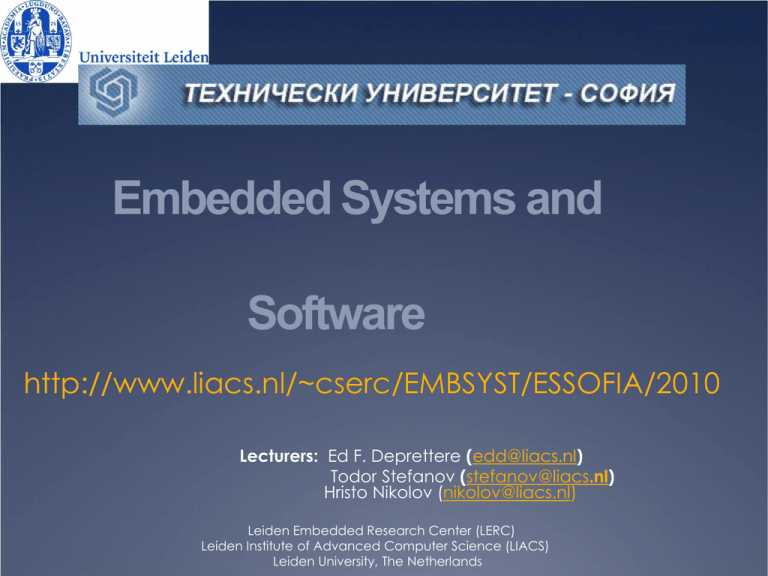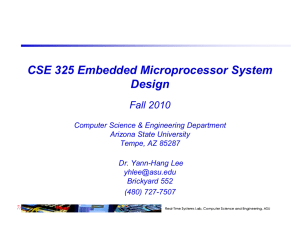Exploring, Programming, and Prototyping MP-SoCs in 24
advertisement

Embedded Systems and Software http://www.liacs.nl/~cserc/EMBSYST/ESSOFIA/2010 Lecturers: Ed F. Deprettere (edd@liacs.nl) Todor Stefanov (stefanov@liacs.nl) Hristo Nikolov (nikolov@liacs.nl) Leiden Embedded Research Center (LERC) Leiden Institute of Advanced Computer Science (LIACS) Leiden University, The Netherlands Course Organization: Class Lectures and Discussions Goal: To introduce students to state-of-the-art methods, techniques, and tools to design, program, implement, and use Embedded Multiprocessor Systems-on-Chip (MPSoC). Format: Oral presentations supported by PowerPoint slides. The slides will be available on the web page after each lecture. Discussions on relevant scientific journal/conference papers. Hands-on tutorials with practical assignments Structure The DAEDALUS framework is used to design and prototype a relatively simple MPSoC Independent study of scientific journal/conference papers Read and study papers on topics related to the course material Presentation on the topic under study 2 Course Organization: Grading There is NO traditional written exam The final grade is a combination of grades for Presentation on a given topic related to the course material (40%) Performance during the hands-on sessions (40%) Pro-active attitude during lectures and paper discussions (20%) 3 Course Literature and Material Some reference books "Embedded System Design" by Peter Marwedel, 1st edition, Kluwer Academic Publishers: Hardbound, October 2003, 258 pp. ISBN-10 1-4020-7690-8; ISBN-13 978-1-4020-7690-9 2nd edition, Springer: Paperback, 2006, 258 pp. ISBN-10 0-387-29237-3; ISBN-13 978-0-387-29237-3 2) "Embedded System Design: Modeling, Synthesis and Verification" by Daniel Gajski, Samar Abdi, Andreas Gerstlauer, and Gunar Schirner, Springer, 2009, XXVI, 358 p. 185 illus., Hardcover ISBN: 978-1-4419-0503-1 "Embedded System Design: A Unified Hardware/Software Introduction" by Frank Vahid and Tony Givargis, John Wiley & Sons; ISBN: 0471386782. Copyright (c) 2002. "Embedded Multiprocessors: Scheduling and Synchronization" by Sundararajan Sriram, Shuvra S. Bhattacharyya, (Marcel Dekker) “Computers as Component, Principles of Embedded Computer Systems Design” by Wayne Wolf, (Morgan Kaufman Publishers) http://www.ee.edu/~wolf/embedded-book/about.html The slides contain (copyright) material of Peter Marwedel, Lothar Thiele, Wayne Wolf, Daniel Gajski, Shuvra Bhattacharyya, Andy Pimentel, Edward Lee, Stephan Edwards and from the above books 4 Contents of Course Introduction to Embedded Systems Embedded Systems Components Embedded Systems Specification and Modeling Models of Computation Specification Languages Basic concepts, methods, techniques, and tools for design of Embedded Systems The DAEDALUS framework for Embedded MPSoC design Automatic parallelization of streaming media applications (KPNgen) System-level modelling and simulations for DSE (Sesame) System-level synthesis in a “plug-and-play” fashion (ESPAM) Case Studies Other System-level design frameworks for MPSoCs System on Chip Environment from the UC Irvine, SystemCoDesigner from the University of Erlangen, Metropolis from the UC Berkeley, Koski from the University of Tampere, PeaCE/HOPES from the Seoul National University, … 5 Introduction to Embedded Systems and Software Outline What is Embedded System? Examples Characteristics of Embedded Systems Comparison Embedded Systems vs. General Purpose Systems Trends in Embedded Systems Embedded Systems Design Future of Embedded Systems 7 What is Embedded Systems? Many Definitions exist: [Peter Marwedel, TU Dortmund] Embedded Systems = Information processing systems embedded into a larger product [Edward A. Lee, UC Berkeley] Embedded Software = Software integrated with physical* processes. The technical problem is managing time and concurrency in computational systems. 8 Yet Another Definition … Embedded Systems = Information processing systems that are: • application domain specific (not general purpose) • tightly coupled to their environment Examples of application domains: automotive electronics, avionics, multimedia, consumer electronics, etc. Environment: type and properties of input/output information. Tightly coupled: the environment dictates what the system’s response behavior must be. (“ES cannot synchronize with environment”)Embedded Systems and Software by Todor Stefanov 2010 9 Embedded Systems What they do: Sense environment (input signals) Process input information Respond in realtime (output signals) In Embedded Systems time matters: NOT in the sense that information processing should be always very fast BUT in the sense that information processing should be: determinate and time predictable Embedded Systems and Software by Todor Stefanov 2010 10 Examples of Embedded Systems: Consumer Electronics Examples: Audio (MP3, …) Video (digital camera, …) Home electronics (washing machine, microwave cooker/oven, …) Embedded Systems and Software by Todor Stefanov 2010 11 Examples of Embedded Systems: Automotive Electronics Functions by embedded processing: Multiple Networks ABS: Anti-lock braking systems ESP: Electronic stability control Efficient automatic gearboxes Theft prevention with smart keys Blind-angle alert systems Airbags ... etc ... Body, engine, media, safety Multiple Processors Up to 100 NetworkedEmbedded togehter Systems and Software by Todor Stefanov 2010 12 Examples of Embedded Systems: Avionics Flight control systems, Anti-collision systems, Pilot information systems, Power supply system, Flap control system, Entertainment system, … Embedded Systems and Software by Todor Stefanov 2010 13 Examples of Embedded Systems: Telecommunication Information systems Wireless communication Mobile phone Wireless LAN Closed systems for police, ambulance, rescue staff Geo-positioning systems Navigation etc Embedded Systems and Software by Todor Stefanov 2010 14 Examples of Embedded Systems: Medical Systems For example Artificial Eye Camera is attached to glasses Computer is worn on belt Output directly connected to the brain Embedded Systems and Software by Todor Stefanov 2010 15 Examples of Embedded Systems: Authentication Systems Finger print sensors Airport security systems Smartpen® Access control Smart cards …. Embedded Systems and Software by Todor Stefanov 2010 16 Examples of Embedded Systems: Industrial Production Systems High-speed bonder (SMD/PCB) Chemical Installation Embedded Systems and Software by Todor Stefanov 2010 17 Examples of Embedded Systems: Robotics NASA's Mars Sojourner Rover Sony Aibo ERS-110 Robotic Dog Embedded Systems and Software by Todor Stefanov 2010 18 Examples of Embedded Systems: Communicating ES Sensor Networks (civil engineering, buildings, environmental monitoring, traffic, etc.) Embedded Systems and Software by Todor Stefanov 2010 19 Examples of Embedded Systems: Very Large Distributed ES Distributed Hierarchical Radio Telescope LOFAR/SKA Station contains: - 100 LF antennas - 100 HF compound antennas 350 km Inner core contains: - supercomputer Embedded Systems and Software by Todor Stefanov 2010 20 Embedded Systems are Everywhere: Smart Beer Glass Capacitive sensor for fluid level Integrates several technologies: 8-bit processor Contact less transmission of power and readings Radio transmissions Sensor technology Magnetic inductance for power Computer used for calibration Impossible without the computer Inductive coil for RF ID activation & Meaningless without the power electronics © Jakob Engblom CPU and reading coil in the table. Reports the level of fluid in the glass, alerts waiters when close to empty Embedded Systems and Software by Todor Stefanov 2010 21 Characteristics of Embedded Systems (1) Must be dependable Reliability: R(t) = probability of a system working correctly provided that it was working at t = 0 Maintainability: M(d) = probability of a system working correctly d time units after error occurred Availability: A(t) = probability of system working at time t Safety: no harm to be caused by failing system Security: confidential and authentic communication -Even perfectly designed systems can fail if the assumptions about the workload and possible errors turn out to be wrong. -Making the system dependable must not be an after-thought, it must be considered from the very beginning. Embedded Systems and Software by Todor Stefanov 2010 22 Characteristics of Embedded Systems (2) Must be efficient Energy efficient Many ES are mobile systems powered by batteries Customers expect long run-times from batteries but Battery technology improves at a very slow rate Code-size efficient (especially for systems on a chip) Typically there are no hard discs or huge memories to store code Run-time efficient Meet time constraints with least amount of HW resources and energy – only necessary HW should be present working at as low as possible Vdd and fclk Weight efficient (especially for portable ES) Cost efficient (especially for high-volume ES) Embedded Systems and Software by Todor Stefanov 2010 23 Characteristics of Embedded Systems (3) Many ES must meet real-time constraints A real-time system must react to stimuli from the controlled object (or the operator) within the time interval dictated by the environment. For real-time systems, right answers arriving too late (or even too early) are wrong. “A real-time constraint is called hard, if not meeting that constraint result inare a catastrophe“ [Kopetz, 1997]. All other could time-constraints called soft. A guaranteed system response has to be explained without statistical arguments. Embedded Systems and Software by Todor Stefanov 2010 24 Characteristics of Embedded Systems (4) Frequently, ES are connected to physical environment through sensors and actuators. Hybrid Systems, i.e., composed of analog and digital parts Typically, ES are reactive systems “A reactive system is one which is in continual interaction with is environment and executes at a pace determined by that environment“ [Bergé, Behavior depends on input and current state.1995]. automata model appropriate Embedded Systems and Software by Todor Stefanov 2010 25 Characteristics of Embedded Systems (5) All ES are dedicated systems Dedicated towards a certain application: Knowledge about the behavior at design time can be used to minimize resources and to maximize robustness Dedicated user interface: No mice, no large keyboards and monitors Not every ES has all of the above characteristics, thus We can define the term “Embedded System” as follows: Information processing systems having most of the above characteristics are called embedded systems. Embedded Systems and Software by Todor Stefanov 2010 26 Comparison Embedded Systems Execute few applications that are known at designtime Non programmable by the end user Fixed run-time requirements (additional computing power not useful) Important criteria Cost General Purpose Systems Execute broad class of applications Programmable by the end user Faster is better Important criteria Cost Average speed Power consumption Embedded Systems and Software by Todor Stefanov 2010 Predictability … 27 Trends in Embedded Systems In the past Embedded Systems were called Embedded (micro-)Controllers They appeared typically in control dominated applications: Traffic lights control Elevators control Washing machines and dishwashers … They were implemented using a single μProcessor or dedicated HW (sequential circuit) All this is rapidly changing nowadays. How And Why? Embedded Systems and Software by Todor Stefanov 2010 28 Trends in Embedded Systems: Towards Multi-Processor Systems Complexity of ES is increasing, thus A single uProcessor is sufficient for some consumer products Application performance demands relatively low For other systems – such as cars and aircrafts – a network of processors is needed Due to performance requirements Due to safety requirements (a single failed component should not cause total system failure) For some systems – such as mobile devices – a network of heterogeneous processors is needed Embedded Systems and Software by Todor Stefanov 2010 Due to run-time efficiency requirements 29 Trends in Embedded Systems: Higher Degree of Integration Moore’s Law: the number of transistors that can be placed on a chip has doubled approximately every two years Microprocessor, microcontroller System-on-Chip (SoC) P CP Processor + memory + I/O-units + communication structure Multi-processor System on a Chip (MPSoC) Processor – Co-processor TM MIPS (Heterogeneous) Multi-processor Network on Chip Embedded Systems and Software by Todor Stefanov 2010 Identical tiles Mem CP1 CP2 30 Trends in Embedded Systems: Software Increasing (amount and complexity) Implementing ES in specialized HW brings lack of flexibility (changing standards) and very expensive masks, thus Most of the functionality will be implemented in software On the average, a human “touches” about 50 to 100 micro-processors per day Average car has 15 micro-processors, luxurious one ~ 60! Exponential increase in software complexity Embedded Systems and Software by Todor Stefanov 2010 31 Embedded Systems Design (1) Embedded Systems Design is NOT just a special case of either hardware (Computer/Electrical Engineering) or software (SoftwareEngineering/Computer Scence) design. An embedded system performs computation that is subject to physical constraints, i.e., interaction with a physical environment and execution on a physical (implementation) platform interaction: deadlines, throughput, jitter execution: available resources, power, failure rates It has functional requirements (expected services), and it has extra-functional requirements Embedded Systems and Software by Todor Stefanov 2010 (performance/cost, robustness, etc.) 32 Embedded Systems Design (2) Computer Science provides (software) functionality for Instruction Set Architectures (ISA) which are characterized by Instruction set Organization (program counter, register file, memory) Both independent of any logical implementation and physical realization Computer/Electrical Engineering deals with Logical implementation Physical realization Embedded Systems design discipline needs to combine these two approaches, because extrafunctional behavior (such as timing, cost, power, robustness, etc.) is a crucial issue when there are real-time constraints imposed by the environment Embedded Systems and Software by Todor Stefanov 2010 when to predict extra-functional behavior using abstract 33 models that cannot be well specified if the relation between Future of Embedded Systems Embedded Systems are everywhere Embedded Systems market will be much larger than the market of PC-like systems Post-PC era in which information processing is more and more moving away from just PCs to embedded systems Embedded Systems provide the basic technology for Ubiquitous/Pervasive computing: Model of human-computer interaction in which information processing has been thoroughly integrated into everyday objects and activities Key goals is to make information available anytime, anywhere Building Ambient Intelligence into our environment Embedded Systems and Software by Todor Stefanov 2010 34 The future is embedded, embedded is the future Embedded Systems and Software by Todor Stefanov 2010 35







